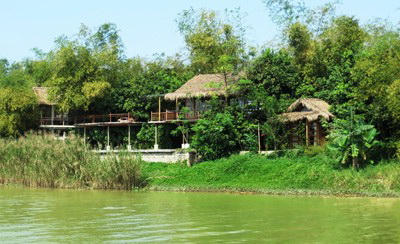To deal with serious erosion on the Thu Bon river (Quang Nam province), many people in Triem Tay village, Phuong Dien commune, Dien Ban district have intended to leave the village to find new land. However, thanks to an eco-tourism project against erosion, they feel assured to settle down on this land.

High risk of landslides
In recent years, the Thu Bon’s river mouth area of Quang Nam province has suffered severely affected storms, big waves and sandexploitation on the river banks. This phenomenon causes serious erosion in the flood season.
Especially, Triem Tay village, Dien Phuong commune, Dien Ban district, Quang Nam province adjacent to the town of Hoi An, located in the Thu Bon River Basin, has frequently suffered the floods on the river. The annual floods caused Triem Tay village severe erosion and flooding of fields. People have worried about the consequences of increasingly harsh nature, many people have intended to move out of the danger zone.
According to scientists, the Thu Bon River estuary located in areas affected by the oceanographic regime and river hydrology, however, the river bears distinct seasonal features. In terms of geology, the Thu Bon river mouth is formed primarily with the creation by medium to coarse sand and easy to change by the effects of fluctuations in water flow.
To address the situation, local authorities have implemented many measures to deal with this problem and make the people feel assured, however, the impacts have always caused confusion and troubles for residents.
Ecological zones in the low land
Finding solutions to dissolve the erosion of the riverside village, Vietnamese-French architect Bui Kien Quoc has researched andfound suitable plan to control the situation.
He has developed eco-tourism zone with the purpose of "keeping the land and village" in the low land. The project aimed to help Triem Tay people not have to leave their village. In 2009, his development project was submitted to the Dien Ban district People's Committee.
He took advantage of the shallow-water season, using stacking sandbags, hammering in bamboo poles to prevent landslides, putting soil inside and planting grasses that have deep root systems to hold soil. From the shore built up by sandbags, short pieces of bamboo on the surface connected to a bamboo fence help break the waves hit, prevent erosion and create conditions for sand accretions. Compensation in place of sand was planted vetiver grass to hold the soil. Each grass bush was planted 30cm apart. This type of grass that is very effective against erosion has been used in the slope on the Ho Chi Minh trail due to the extensive and entrenched roots in the soil.
On the safe land, Mr. Bui Kien Quoc built a 30-sq meter two-story house using cylindrical concrete beams, the first floor is empty, 6-sq meter toilet was built by bricks. Upstairs is a bedroom, kitchen and a small living room. With a capital investment of about VND 100 million, a similar house can be built in only 6 weeks. Bui Kien Quoc said that we had no worry of landslides and typhoons anymore.
Currently, surrounding his house, he built another 50-sq meter house. This model to prevent landslide in the village of Triem Tay is a good example against erosion. It can be replicated in appropriate areas.
At present, local people believed that humans can conquer nature and the Triem Tay villagers have their peace of mind living on the land of their ancestors. Since then, ecotourism model also begin to develop, provides career and income for the local people. A bright new future full of hope for Triem Tay people are waiting ahead.